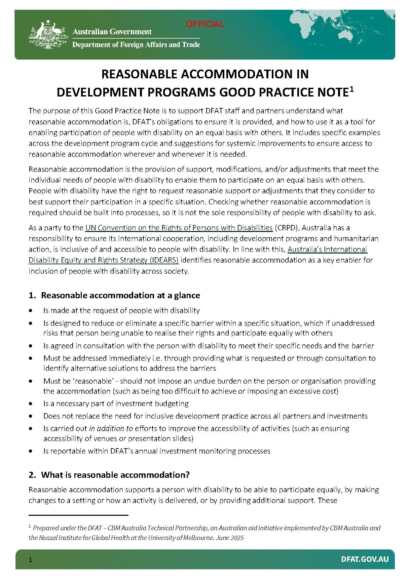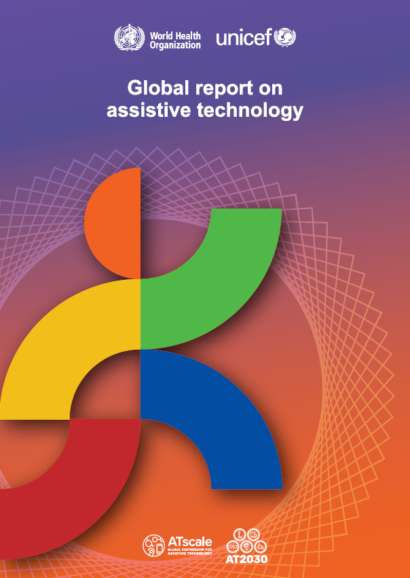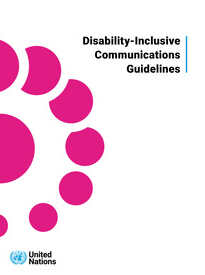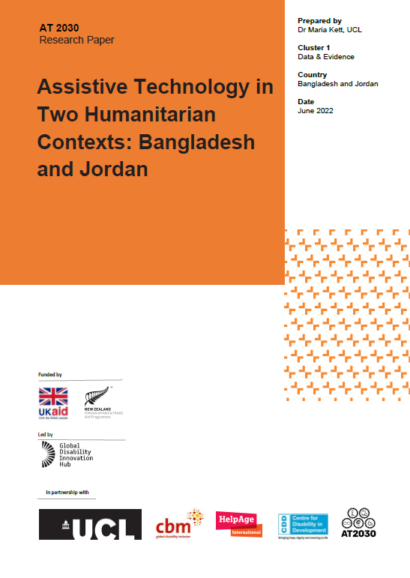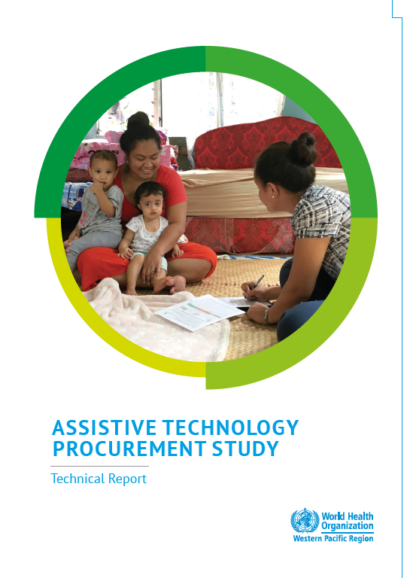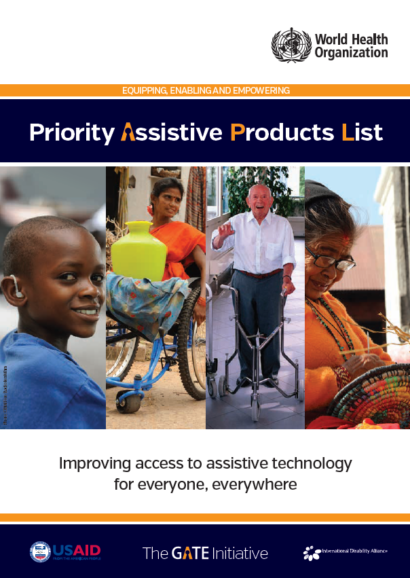DFAT (2025) Reasonable Accommodation in Development Programs Good Practice Note
Supports DFAT staff and partners to understand what reasonable accommodation is, DFAT’s obligations to ensure it is provided, and how to use it as a tool for enabling participation of people with disability on an equal basis with others.
CBM-Nossal (2024) Disability Equity and Rights Essay: Rehabilitation and assistive technologies in disability-inclusive development and health systems
This ‘Disability equity and rights: Challenges, opportunities, and ways forward for inclusive development’ publication was prepared under the DFAT – CBM Inclusion Advisory Group Disability Inclusion Technical Partnership, an Australian aid initiative implemented by CBM Inclusion Advisory Group and the Nossal Institute for Global Health at the University of Melbourne.
CBM-Nossal (2024) Disability Equity and Rights Essay: Disability, digital information and communications technologies – challenges and opportunities for digital inclusion
This ‘Disability equity and rights: Challenges, opportunities, and ways forward for inclusive development’ publication was prepared under the DFAT – CBM Inclusion Advisory Group Disability Inclusion Technical Partnership, an Australian aid initiative implemented by CBM Inclusion Advisory Group and the Nossal Institute for Global Health at the University of Melbourne.
WHO & UNICEF (2022) Global Report on Assistive Technology
The Global Report on Assistive Technology highlights the status of access to assistive technology (AT), and draws attention to the need for and benefit of AT, including the return of investment.
The ILO Global Business and Disability Network & Fundación ONCE (2021) An Inclusive Digital Economy for People with Disabilities
This report takes a closer look at the digital transformation of the world of work and how it impacts people with disabilities.
Smart Cities for All (2017) G3ict’s Smart Cities for All Toolkit
The toolkit contains resources on how to implement ICT accessibility and digital inclusion of people with disabilities in the development of Smart Cities.
CBM Global IAG (2021) Accessible meetings and events: a toolkit
This toolkit provides guidance on organising accessible and inclusive events and meetings in planning, delivery and follow-up stages, and includes a useful checklist that helps with event planning.
World Blind Union & CBM Global (2020) AccessibilityGO! A Guide to Action
This guide provides practical support on how to deliver a whole-of-organisation approach towards accessibility.
IDA (2021) Universal Design for Learning and its Role in Ensuring Access to Inclusive Education for All
This paper provides recommendations for education professionals and civil society stakeholders oh how to promote UDL and use it as a tool to facilitate inclusive education.
DFAT (2013) Accessibility Design Guide: Universal design principles for Australia’s aid program
This guide is intended to assist development practitioners in creating and implementing programs that minimises barriers and are accessible.
CBM (2017) Digital Accessibility Toolkit
This toolkit provides an overview of accessible ICT and offers tools and guidance for creating accessible content, such as accessible websites and online forms.
UNDESA (2018) Disability and Development Report: Chapter 2 (ICT)
Chapter 2 of the Disability and Development Report reflects on overall progress towards the Sustainable Development Goals (SDGs) from the perspective of persons with disabilities, including access to information.
World Bank Group (2022) Accessibility in the ICT Sector of Operations
This fact sheet provides a holistic overview of the importance of making ICT accessible to people with disabilities.
Global Infrastructure Hub (2019) Reference Tool on Inclusive Infrastructure and Social Equity
This reference tool by the Global Infrastructure Hub is intended to help governments and other stakeholders understand and implement the critical success factors that deliver inclusive infrastructure.
Disability Inclusive and Accessible Urban Development Network, World Enabled & CBM (2016) The Inclusion Imperative: Towards Disability-Inclusive and Accessible Urban Development
This booklet produced for the Disability Inclusive and Accessible Urban Development Network was developed to provide recommendations on how to make urban development accessible and inclusive.
World Bank (2022) Technical Note on Accessibility
This technical note covers various accessibility barriers, recommendations, methodologies, and strategies, with a particular focus on persons with disabilities.
UNESCAP (2019) Disability at a Glance 2019: Investing in Accessibility in Asia and the Pacific
The report lays out foundational concepts and terminologies related to disability and accessibility, and outlines the tools and approaches for successful investment in accessibility.
WHO Assistive Technology Assessment (ATA) Toolkit
The WHO ATA Toolkit supports countries in systematically collecting data related to AT.
United Nations Disability Inclusion Strategy (2022) Disability-Inclusive Communications Guidelines
The guidelines provide practical information on how to include and represent people with disabilities in communications, and how to make communications inclusive of and accessible to people with disabilities.
Global Disability Innovation Hub (2023) Accessible ICTs
This key list presents information about accessible information and communication technologies (ICTs).
UNICEF (2021) Toolkit on Accessibility
This toolkit provides advice on how to apply universal design across premises and programs in order to promote access for all.
ATScale Global Partnership
ATScale is the Global Partnership for Assistive Technology hosted by United Nations Office for Project Services (UNOPS). It is a cross-sector global partnership with a mission to transform people’s lives through assistive technology (AT).
AT 2030 (2022) Assistive Technology in Two Humanitarian Contexts: Bangladesh and Jordan
This study looks at the need for and provision of assistive technology (AT) in two humanitarian response contexts: Bangladesh and Jordan.
WHO (2020) Assistive Technology Procurement Study
This study sheds light on the challenges people in Pacific Island Countries currently face when trying to access assistive technology (AT) and the barriers to AT procurement.
WHO (2016) Priority Assistive Products List
The Priority Assistive Products List (APL) was introduced to improve access to high-quality, affordable assistive products in all countries as part of the Global Cooperation on Assistive Technology (GATE).
WHO (2021) Assistive product specifications and how to use them
This document provides guidance for procurement teams on good practice surrounding assistive product procurement and provision.
CBM Australia (2024) Reasonable Accommodations
This policy note provides a high-level overview of CBM Australia's understanding of, and policy position on reasonable accommodations. It also outlines CBMA's engagement in conjunction with its partners.
UN Women (2021) Accessibility and Reasonable Accommodation
This brief explores what is meant by accessibility and reasonable accommodations, and how organisations can understand these concepts to strengthen their approach to disability inclusion.

